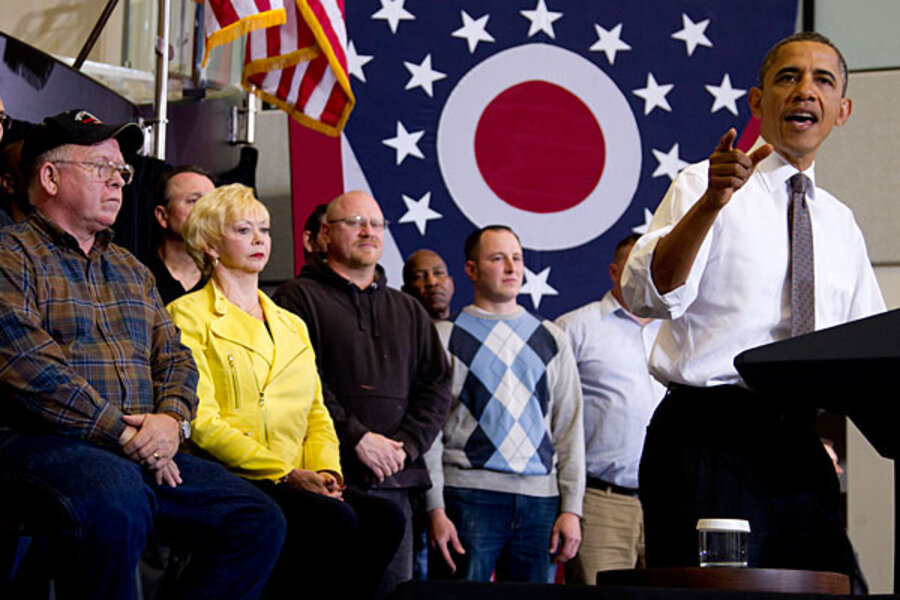Unemployment rates fall in most swing states. Why that may not help Obama.
Loading...
| New York
The state-by-state unemployment numbers, released Friday, held some encouraging news for President Obama and his reelection prospects, with the jobless rate dropping in September in seven of nine electoral battleground states and rising in none. But because the rate remains relatively high in many swing states, it remains to be seen if Mr. Obama can capitalize on the improvement.
Nationally, unemployment rates fell in 41 states and the District of Columbia from August to September, the US Bureau of Labor Statistics (BLS) reported, in its last look at state joblessness before the Nov. 6 election. Six states saw their unemployment rates rise, and three registered no change.
“Obviously if you are an incumbent president, you will welcome any good news, and this is good news just two weeks before the election,” says Larry Sabato of the University of Virginia’s Center for Politics. “But, and this is a big but, the vast majority of voters have already decided, so a small tick-down in their state unemployment rate is not going to change their minds.”
The issue of jobs, or lack of jobs, has been a central theme of Mr. Obama's Republican rival, Mitt Romney. Mr. Romney is campaigning hard on the message that he, as a former corporate CEO, can get the US economy humming again. Obama has been trying to highlight the economic progress made since the very steep downturn that gripped the nation when he took office in 2009.
Examined over the course of a year, unemployment rates fell in eight of the battleground states – Ohio, Florida, North Carolina, Colorado, Iowa, New Hampshire, Virginia, and Nevada. Only New Hampshire has seen its jobless rate rise over the past year.
“The question for the swing states is whether the improvement over the year is keeping up with the population growth,” says Keith Hall, a senior research fellow at George Mason University’s Mercatus Center and a former official at the BLS.
The US population is growing at about 0.8 percent per year. “Any job growth over 1 percent represents progress,” says Mr. Hall. “Many states still have a long way to go before they are full recovered.”
The swing states where unemployment rates fell the most are Florida, Nevada, North Carolina, and Ohio. Florida’s unemployment rate is 8.7 percent, down from 10.4 percent a year ago. North Carolina's dropped from 10.7 percent to 9.6 percent. Nevada is 11.8 percent, down from 13.6 percent. And Ohio's rate fell from 8.6 percent to 7 percent.
Mr. Sabato perceives the Obama campaign as having missed opportunities to trumpet the improvement.
One reason it hasn't may be because rates in some states are still so high. For example, in Nevada at least 1 in 10 people is still out of work. “You can’t really say, 'Gee, things are getting better,' ” he says. “They are just not as horrible as they were.”
In hotly contested Ohio, the unemployment rate is below the national average of 7.8 percent, and the state added about 88,000 jobs in sectors ranging from manufacturing to finance in the past year. Still, it's not something Ohioans hear much about from Obama, Sabato says.
“The Obama campaign does not want to bring up the subject because they reason the more [that] people think about the economy, the more they will vote for Romney,” he says.
In Florida, where the unemployment rate has dropped 1.7 percentage points over the year, the improvement has not helped Obama in the polls.
That is partly because a lot of people are working only part time, or have jobs that pay less money than before the recession, says Susan MacManus, a professor at the University of South Florida. Moreover, the state is still bedeviled by a high rate of home foreclosures, she notes.
“You have to remember that Florida for years was always leading other states out of the recession, but since the last downturn it has been lagging behind,” she says. “There is an impatience factor here.”
Even in states where the unemployment rate is below the national average, the gains have not seemed to help Obama that much. Virginia is leaning toward Romney, though the unemployment rate has fallen 0.4 percentage points in the past year. Job growth in Virginia has come from professional services, education, and leisure and hospitality.
“I live in Virginia, where the unemployment rate is under 6 percent, and the Obama campaign is not using it,” Sabato says. “It’s almost malpractice.”
For most of the other battleground states, improvements in the jobless rate over the past year have been modest. Iowa is down 0.7 percentage points, Wisconsin is down one-tenth of a point, and Colorado is down two-tenths of a point.
Another key state is North Carolina, where unemployment is still a high 9.6 percent. “North Carolina’s recovery continues to be bumpy,” said IHS Global Insight, an economic forecasting firm in Lexington, Mass., in a recent analysis.
“The good news is that the state’s two largest sectors, government and education/health services, have both been generating fairly consistent job growth, and the manufacturing sector appears to be hanging on to its recovery,” said the analysis.
However, the improvement has not helped Obama. According to the latest Politico swing state analysis, the Tar Heel State is leaning toward Romney.
On Nov. 2, the BLS will release the October jobs numbers, the last look at the national unemployment picture before the election. “That can have an impact,” says Sabato.
But during an election year, he adds, a lot of people become suspicious of economic numbers. Last month, Republican commentators howled when the unemployment rate dropped from 8.1 percent to 7.8 percent.
“A lot of people thought the books were cooked,” says Sabato. “I am not one of those. But most people don’t think the jobless rate is 7.8 percent.”







